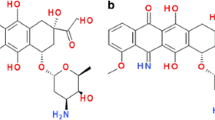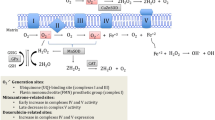Abstract
Dexrazoxane is highly effective in reducing anthracycline-induced cardiotoxicity and extravasation injury and is used clinically for these indications. Dexrazoxane has two biological activities: it is a prodrug that is hydrolyzed to an iron chelating EDTA-type structure and it is also a strong inhibitor of topoisomerase II. Doxorubicin is able to be reductively activated to produce damaging reactive oxygen species. Iron-dependent cellular damage is thought to be responsible for its cardiotoxicity. The available experimental evidence supports the conclusion that dexrazoxane reduces doxorubicin cardiotoxicity by binding free iron and preventing site-specific oxidative stress on cardiac tissue. However, it cannot be ruled out that dexrazoxane may also be protective through its ability to inhibit topoisomerase II.




Similar content being viewed by others
References
Swain, S. M., & Vici, P. (2004). The current and future role of dexrazoxane as a cardioprotectant in anthracycline treatment: Expert panel review. Journal of Cancer Research and Clinical Oncology, 130, 1–7.
Minotti, G., Recalcati, S., Menna, P., Salvatorelli, E., Corna, G., & Cairo, G. (2004). Doxorubicin cardiotoxicity and the control of iron metabolism: Quinone-dependent and independent mechanisms. Methods in Enzymology, 378, 340–361.
Herman, E. H., & Ferrans, V. J. (1990). Examination of the potential long-lasting protective effect of ICRF-187 against anthracycline-induced chronic cardiomyopathy. Cancer Treatment Reviews, 17, 155–160.
Hasinoff, B. B., Hellmann, K., Herman, E. H., & Ferrans, V. J. (1998). Chemical, biological and clinical aspects of dexrazoxane and other bisdioxopiperazines. Current Medicinal Chemistry, 5, 1–28.
Diop, N. K., Vitellaro, L. K., Arnold, P., Shang, M., & Marusak, R. A. (2000). Iron complexes of the cardioprotective agent dexrazoxane (ICRF-187) and its desmethyl derivative, ICRF-154: Solid state structure, solution thermodynamics, and DNA cleavage activity. Journal of Inorganic Biochemistry, 78, 209–216.
Hasinoff, B. B., Schroeder, P. E., & Patel, D. (2003). The metabolites of the cardioprotective drug dexrazoxane do not protect myocytes from doxorubicin-induced cytotoxicity. Molecular Pharmacology, 64, 670–678.
Hasinoff, B. B. (2002). Dexrazoxane (ICRF-187) protects cardiac myocytes against hypoxia-reoxygenation damage. Cardiovascular Toxiciology, 2, 111–118.
Fortune, J. M., & Osheroff, N. (2000). Topoisomerase II as a target for anticancer drugs: When enzymes stop being nice. Progress in Nucleic Acid Research Molecular Biology, 64, 221–253.
Swift, L. M., & Sarvazyan, N. (2000). Localization of dichlorofluorescin in cardiac myocytes: Implications for assessment of oxidative stress. American Journal of Physiology and Heart and Circulatory Physiology, 278, H982–H990.
Hasinoff, B. B., Schnabl, K. L., Marusak, R. A., Patel, D., & Huebner, E. (2003). Dexrazoxane (ICRF-187) protects cardiac myocytes against doxorubicin by preventing damage to mitochondria. Cardiovascular Toxiciology, 3, 89–99.
Sarvazyan, N. (1996). Visualization of doxorubicin-induced oxidative stress in isolated cardiac myocytes. American Journal of Physiology, 271, H2079–H2085.
Malisza, K. L., & Hasinoff, B. B. (1996). Hydroxyl radical production by the iron complex of the hydrolysis product of the antioxidant cardioprotective agent ICRF-187 (dexrazoxane). Redox Report, 2, 69–73.
Schroeder, P. E., Jensen, P. B., Sehested, M., Hofland, K. F., Langer, S. W., & Hasinoff, B. B. (2003). Metabolism of dexrazoxane (ICRF-187) used as a rescue agent in cancer patients treated with high-dose etoposide. Cancer Chemotherapy and Pharmacology, 52, 167–174.
Schroeder, P. E., & Hasinoff, B. B. (2005). Metabolism of the one-ring open metabolites of the cardioprotective drug dexrazoxane to its active metal chelating form in the rat. Drug Metabolism and Disposition, 33, 1367–1372.
Hasinoff, B. B., Kuschak, T. I., Yalowich, J. C., & Creighton, A. M. (1995). A QSAR study comparing the cytotoxicity and DNA topoisomerase II inhibitory effects of bisdioxopiperazine analogs of ICRF-187 (dexrazoxane). Biochemical Pharmacology, 50, 953–958.
Classen, S., Olland, S., & Berger, J. M. (2003). Structure of the topoisomerase II ATPase region and its mechanism of inhibition by the chemotherapeutic agent ICRF-187. Proceedings of the National Academy Sciences of the United States of America, 100, 14510.
Hasinoff, B. B., Abram, M. E., Chee, G.-L., Huebner, E., Byard, E. H., Barnabé, N., Ferrans, V. J., Yu, Z.-X., & Yalowich, J. C. (2000). The catalytic DNA topoisomerase II inhibitor dexrazoxane (ICRF-187) induces endopolyploidy in Chinese hamster ovary cells. The Journal of Pharmacology and Experimental Therapeutics, 295, 474–483.
Hasinoff, B. B., Abram, M. E., Barnabé, N., Khelifa, T., Allan, W. P., & Yalowich, J. C. (2001). The catalytic DNA topoisomerase II inhibitor dexrazoxane (ICRF-187) induces differentiation and apoptosis in human leukemia K562 cells. Molecular Pharmacology, 59, 453–461.
Hasinoff, B. B., Yalowich, J. C., Ling, Y., & Buss, J. L. (1996). The effect of dexrazoxane (ICRF-87) on doxorubicin- and daunorubicin-mediated growth inhibition of Chinese hamster ovary cells. Anticancer Drugs, 7, 558–567.
Sehested, M., Jensen, P. B., Sorensen, B. S., Holm, B., Friche, E., & Demant, E. J. F. (1993). Antagonistic effect of the cardioprotector (+)-1,2-bis(3,5-dioxopiperazinyl-1-yl)propane (ICRF-187) on DNA breaks and cytotoxicity induced by the topoisomerase II directed drugs daunorubicin and etoposide (VP-16). Biochemical Pharmacology, 46, 389–393.
Hasinoff, B. B., Kuschak, T. I., Creighton, A. M., Fattman, C. L., Allan, W. P., Thampatty, P., & Yalowich, J. C. (1997). Characterization of a Chinese hamster ovary cell line with acquired resistance to the bisdioxopiperazine dexrazoxane (ICRF-187) catalytic inhibitor of topoisomerase II. Biochemical Pharmacology, 53, 1843–1853.
Pouillart, P. (2004). Evaluating the role of dexrazoxane as a cardioprotectant in cancer patients receiving anthracyclines. Cancer Treatment Reviews, 30, 643–650.
Swain, S. M., Whaley, F. S., Gerber, M. C., Weisberg, S., York, M., Spicer, D., Jones, S. E., Wadler, S., Desai, A., Vogel, C., Speyer, J., Mittelman, A., Reddy, S., Pendergrass, K., Velez-Garcia, E., Ewer, M. S., Bianchine, J. R., & Gams, R. A. (1997). Cardioprotection with dexrazoxane for doxorubicin-containing therapy in advanced breast cancer. Journal of Clinical Oncology, 15, 1318–1332.
Acknowledgments
This work was supported by the Canadian Institutes of Health Research, the Canada Research Chairs program and a Canada Research Chair in Drug Development for Brian Hasinoff.
Author information
Authors and Affiliations
Corresponding author
Rights and permissions
About this article
Cite this article
Hasinoff, B.B., Herman, E.H. Dexrazoxane: how it works in cardiac and tumor cells. Is it a prodrug or is it a drug?. Cardiovasc Toxicol 7, 140–144 (2007). https://doi.org/10.1007/s12012-007-0023-3
Published:
Issue Date:
DOI: https://doi.org/10.1007/s12012-007-0023-3




